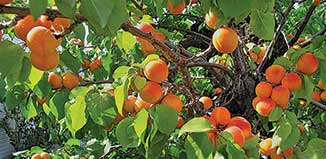
The apricot (Prunus armeniaca) grows naturally as a slender tree. A member of the rose family, it has delicate, white blossoms that emerge in a lacy froth in early spring, followed by soft, green leaves that shelter developing fruit. One of the first deciduous fruit trees to flower, they bear when the trees are young, crop before the worst of brown rot strikes in humid areas, thrive in cold, frosty ones — and the trees stay a manageable size. With its pale to deep orange flesh, their succulent fruit is irresistible –what’s not to love about the apricot?
The fruit is also a winner in the home garden. Left to ripen on the tree, their flavour is unequalled, giving your home-grown fruit a distinct advantage over store-bought (but if picked too early they stay tart).
Although originating in China’s Tien Shan region with its chilly winters and hot summer sun (think Central Otago), plant breeders have now developed varieties that do well in warmer areas such as the semi-dwarf ‘Katy Cot,’ a large, tasty fruit, great eating, early ripening, disease-resistant and self-fertile. ‘Solar Perfection’ is a new variety of early eating apricot suitable for warmer climates such as Otaki. It produces good-sized, juicy fruit and is available from Te Horo Garden Centre. ‘Sundrop’ is an excellent cropper over a long period with sweet, juicy yellow fruit — for really good crops use ‘Trevatt’ as a pollinator.
Commercially, Trevatt, Clutha Gold and Sundrop apricots are grown successfully in Gorge Road
If you have room for more than one variety try ‘Fitzroy,’ a later ripening type (planting different varieties will spread eating season from December to February), and a consistently heavy cropper. With limited space choose a self-fertile variety that fruits when you have a gap in your garden’s fruit production — or look for a tree with two varieties grafted onto its rootstock.
Apricots grow best in well-drained, light and medium loams and young trees need plenty of water in dry summers until they are well established (stake if needed). Keep the ground around your tree clear of weeds and grass — these will slow the growth of a young tree. Lime the soil to create and maintain a pH of about 6, and feed trees every year with a well-balanced orchard fertiliser.
Prune in dry summer weather after fruit is harvested. With a young tree aim to create a good, strong framework that will last many years. To prune an established tree, remove broken and diseased branches and cut out non-fruiting wood. Fruit develops on spurs formed in the growing previous season — this continues to produce fruit for up to four years before becoming unproductive. During summer months you can cut back some of the new, strong growth once or twice to encourage new fruiting spurs to develop.
Fruit trees are available from Waimea Nurseries www.waimeanurseries.co.nz, Diacks Nurseries, www.diacks.co.nz, Kaipara Coast Plant Centre, www.plantsnz.co.nz and Te Horo Garden Centre.

